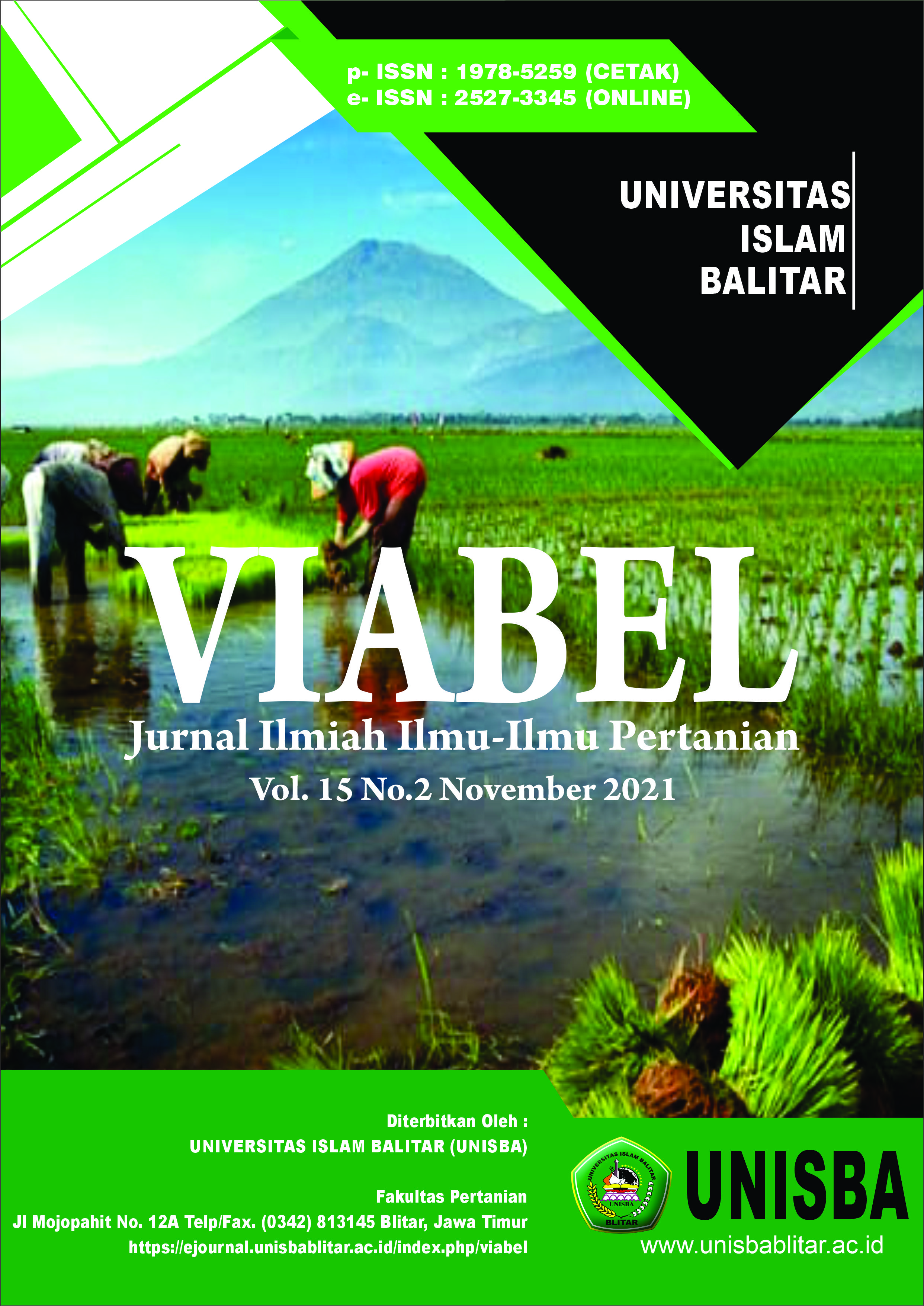A THE EFFECT OF DOSE AND TIME OF ADMINISTRATION OF TRICHODERMA SP ON FUSARIUM OXYSPORUM ON SHALLOT (Allium ascalonicum L)
Trichoderma sp, fusariumi oxysporum.
DOI:
https://doi.org/10.35457/viabel.v15i2.1700Keywords:
Keywords : Trichoderma sp, fusarium oxysporum, shallot.Abstract
ABSTRACTThis studypaimsptopdeterminepthe appropriate dosepand time ofxadministration ofxTrichoderma sp to control Fusarium oxysporum disease in shallot plants. Thepresearch waspconductedpfrompSeptemberp2020ptoxDecemberx2020 in Karangasem Hamlet, Guli Village, Nogosari District, Boyolali Regency. Thispstudypusedpapfactorialpcompletely randomizedpdesign (RAL) methodpwhich consisted ofp2pfactors. Thepfirst treatmentpfactor was thepdose ofpTrichoderma sp (D) which consisted of 3 g, 5g, 7g and the time of administration (T) which was one week before planting, during planting and a week after planting. Parameterspobservedpwerepnumberpof leaves, number ofptubers, weightpof fresh stover, weight of dry stover and intensity of disease attack. The results showed that the treatment with the best Trichoderma sp (D) dose was obtained in the D3 treatment with a dose of 7 grams / liter of solution had a very significant effect on the number of leaves, fresh stover, dry stover, intensity of disease attack and not significantly different on the number of tubers. The best time treatment for giving Trichoderma sp (T) was obtained in T1 treatment, namely the time of administration one week before planting had a significant effect on the number of leaves, fresh stover, and was not significantly different on the number of tubers, dry stover, intensity of disease attack. Meanwhile, the best combination of dosage and time of administration of Trichoderma sp was obtained in the (D3T1) treatment, namely the administration of a dose of 7 grams / liter of solution and the time of administration one week before planting had a significant effect on dry stover and had no significant effect on other parameters.
Keywords : Trichoderma sp, fusarium oxysporum, shallot.
Downloads
References
[Balitbangtan] Badan Litbang Pertanian. 2006. Prospek dan Arah Pengembangan Agribisnis Bawang Merah. Jakarta: Badan Penelitian dan Pengembangan Pertanian Kementerian Pertanian.
AAK, 1998. Pedoman Bertanam Bawang. Kanisius, Yogyakarta.
Anonim. 2002. Pedoman Penerapan Agen Hayati Dalam Pengendalian OPT Tanaman Sayuran. Direktorat Jenderal Bina Produksi Hortikultura. Direktorat Perlindungan Hortikultura. Jakarta. 49 hal.
Arwiyanto, T. 2003. Pengendalian hayati penyakit layu bakteri tembakau. Jurnal Perlindungan Tanaman Indonesia 3 (1) : 54-60.
Departemen Pertanian, 2011. Prospek Bawang Merah. www.litbang.deptan.go.id. Diunduh Pada tanggal 24 Februari 2011.
Estu Rahayu. 2007. Bawang Merah. Jakarta: Penebar Swadaya.
Herlina L, Dewi P & Mubarok I, 2004. Efektivitas biofungisida Trichoderma viride terhadap pertumbuhan tomat. Laporan Penelitian. Semarang: FMIPA UNNES.
Lewis, J.A. and G.C. Papavizas. 1983. Production of Clamidospores and Conidia by Trichoderma sp. In Liquid and Solid Growth Media. Soil Biology and Biochemistry, 15 (4): 351-357.
Purwantisari, S & Rini, BH 2009, ‘Uji antagonisme jamur patogen Phytophthora infestans penyebab penyakit busuk daun dan umbi tanaman kentang dengan menggunakan Trichoderma spp. isolat lokal’, BIOMA, vol. 11, no. 1, pp. 24-32.
Rismunandar. 1989. Sorgum Tanaman Serba Guna. Sinar Baru. Bandung.
Rukmana, E 2004 Teknik Pelaksanaan Kegiatan Efikasi Zat Perangsang Tumbuh Pada Bawang Merah. Buletin Teknik Pertanian Vol. 9. No 2, 2004.
Rukmana, R, 1995. Bawang Merah Budidaya Dan Pengolahan Pasca Panen. Kanisius, Jakarta.
Samadi, B. dan B. Cahyono. 2005. Intensifikasi Budidaya Bawang Merah. Kanisius. Yogyakarta. 74 hal.
Sastrahidayat, I.R. 1992. Ilmu Penyakit Tumbuhan. Surabaya: Usaha Nasional. 365 Ha
Sastrahidayat. (1990) dalam Diniyah, S. (2010). Potensi Bakteri Endofit Sebagai Penghambat Pertumbuhan Bakteri (Ralstonia solanacearum) dan jamur (Fusarium sp. Dan Phytopthora investans) penyebab penyakit layu pada tanaman.Hal 19-20. http://etheses.uin-malang.ac.id/963/. Diakses 5 juli 2017.
Steinhaus EA. 1963. Insertc microbiology. New york. : comstock publising company, inc.
Sudantha, I. M. dan A.L. Abadi. 2007. Identifikasi Jamur Endofit dan Mekanisme Antagonismenya terhadap Jamur Fusarium oxysporum f. sp. vaniliae pada Tanaman Vanili. Jurnal Agroteksos 17(1):23-38.
Sudewa, KA, Suprapta, DN & Mahendra, MS 2008, ‘Residu pestisida pada sayuran kubis (Brassica oleracea L.) dan kacang panjang (Vigna sinensis L.) yang dipasarkan di pasar Badung Denpasar’, Ecotrophic, vol. 4, no. 2, pp. 125‐30.
Sutarya, R dan Grubben G. 1995. Pedoman Bertanam Sayuran Dataran Rendah Gajah Mada University Press. Prosea Indonesia Balai Panel. Hortikultura, Lembang.
Tjitrosoepomo, gembong. 2010. Taksonomi Tumbuhan Spermatophyta. Yogyakarta: Gajah Mada University press.
Trianto dan Gunawan Sumantri. 2003. Pengembangan Trichoderma harzianum untuk pengendalian OPT Pangan dan Hortikultura. Makalah. Lab. PHPT Wilayah Semarang.
Wibowo, S. 2005. Budi Daya Bawang Putih, Merah dan Bombay. Jakarta: Penebar Swadaya. hal: 17-23.
Wiyatiningsih S., 2003. Kajian Asosiasi Phytophthora sp. dan Fusarium oxysporum f. sp. cepae Penyebab Penyakit Moler pada Bawang Merah. Mapeta, 5:1 – 6
Yunasfi. 2002. Faktor-Faktor yang Mempengaruhi Perkembangan Penyakit dan Penyakit yang Disebabkan Oleh Jamur. Fakultas Pertanian Jurusan Ilmu Kehutanan Universitas Sumatera Utara.USU Digital Library. http://library.usu.ac.id/download/fp/hutan-yunasfi.pdf [15 November 2013].
Downloads
Published
Issue
Section
License
Copyright (c) 2021 VIABEL: Jurnal Ilmiah Ilmu-Ilmu Pertanian

This work is licensed under a Creative Commons Attribution-ShareAlike 4.0 International License.
Authors who publish with this journal agree to the following terms:
- Copyright on any article is retained by the author(s).
- The author grants the journal, right of first publication with the work simultaneously licensed under a Creative Commons Attribution License that allows others to share the work with an acknowledgment of the work’s authorship and initial publication in this journal.
- Authors are able to enter into separate, additional contractual arrangements for the non-exclusive distribution of the journal’s published version of the work (e.g., post it to an institutional repository or publish it in a book), with an acknowledgment of its initial publication in this journal.
- Authors are permitted and encouraged to post their work online (e.g., in institutional repositories or on their website) prior to and during the submission process, as it can lead to productive exchanges, as well as earlier and greater citation of published work.
- The article and any associated published material is distributed under the Creative Commons Attribution-ShareAlike 4.0 International License










.png)




